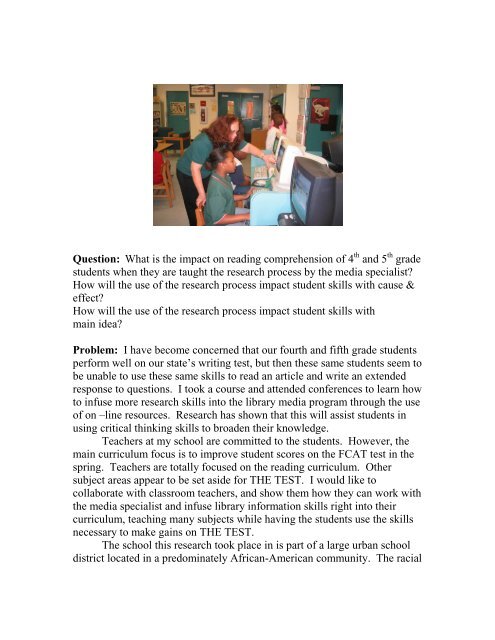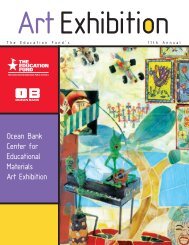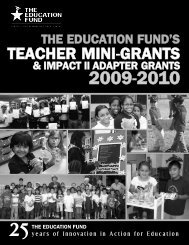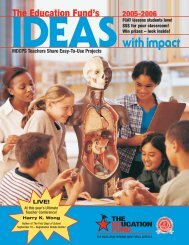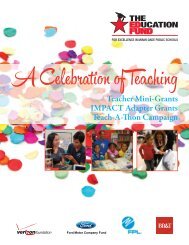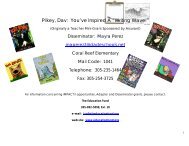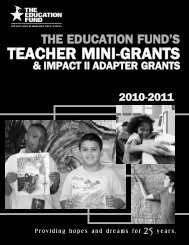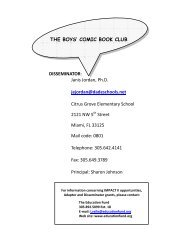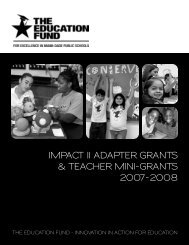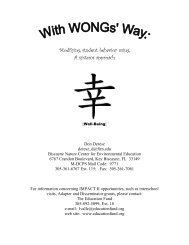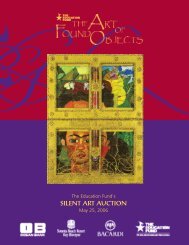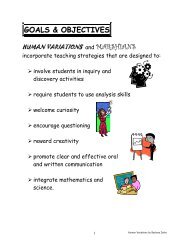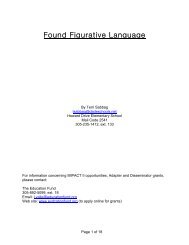Dottie Hammer Reading Comprehension - The Education Fund
Dottie Hammer Reading Comprehension - The Education Fund
Dottie Hammer Reading Comprehension - The Education Fund
You also want an ePaper? Increase the reach of your titles
YUMPU automatically turns print PDFs into web optimized ePapers that Google loves.
Question: What is the impact on reading comprehension of 4 th and 5 th grade<br />
students when they are taught the research process by the media specialist?<br />
How will the use of the research process impact student skills with cause &<br />
effect?<br />
How will the use of the research process impact student skills with<br />
main idea?<br />
Problem: I have become concerned that our fourth and fifth grade students<br />
perform well on our state’s writing test, but then these same students seem to<br />
be unable to use these same skills to read an article and write an extended<br />
response to questions. I took a course and attended conferences to learn how<br />
to infuse more research skills into the library media program through the use<br />
of on –line resources. Research has shown that this will assist students in<br />
using critical thinking skills to broaden their knowledge.<br />
Teachers at my school are committed to the students. However, the<br />
main curriculum focus is to improve student scores on the FCAT test in the<br />
spring. Teachers are totally focused on the reading curriculum. Other<br />
subject areas appear to be set aside for THE TEST. I would like to<br />
collaborate with classroom teachers, and show them how they can work with<br />
the media specialist and infuse library information skills right into their<br />
curriculum, teaching many subjects while having the students use the skills<br />
necessary to make gains on THE TEST.<br />
<strong>The</strong> school this research took place in is part of a large urban school<br />
district located in a predominately African-American community. <strong>The</strong> racial
make-up is 91% Black and 9% Hispanic. Twenty-three fourth and fifth<br />
grade students participated in this action research project.<br />
Research: Wolf, Brush, and Saye (2003) found compelling evidence of a<br />
link between metacognitive skills (thinking about thinking) and the Big6<br />
information problem-solving model. <strong>The</strong>y found that the Big6 acts as a<br />
metacognitive scaffold for students to be successful in a variety of problemsolving<br />
learning activities. <strong>The</strong> Big6 can be applied to a variety of learning<br />
situations, both inside and outside of the classroom. Teachers can use this<br />
and other information problem-solving models to systematically teach<br />
problem solving skills.<br />
Joan Yoshina (1995-1997), library media specialist was part of a team<br />
consisting of three teachers and Violet Harada, an associate professor at the<br />
University of Hawaii. <strong>The</strong>re action research showed that student progress<br />
can be effectively assessed as they worked through the Information Search<br />
Process by using journals, rubrics and process-folios.<br />
This action research team is using their findings to improve their<br />
current efforts and to use with other teachers in the school to integrate<br />
curricula. <strong>The</strong> results were also shared with educators in other schools at the<br />
district and state level.<br />
Data / Tools: Different forms of data are being used. <strong>The</strong> students took a<br />
computerized reading comprehension pretest, as well as a mock FCAT<br />
exam. <strong>The</strong> test shows that the students range in reading level from high first<br />
grade to seventh grade. <strong>The</strong> mock FCAT scores were also analyzed. I<br />
decided to focus on two comprehension skills: main idea and cause / effect.<br />
Lesson plans, attendance records, classroom teacher’s grades, researcher<br />
observations, interviews, as well as student work will also be used as data.<br />
<strong>The</strong> fourth grade students gained 0.27 grade equivalent on the STAR<br />
test in the semester before the project began. <strong>The</strong>se same students gained<br />
0.48 grade equivalent level during the project. <strong>The</strong> fourth grade students<br />
also improved an average of 5.42 points on the MOCK FCAT test.<br />
<strong>The</strong> fifth grade students that participated in the project gained an<br />
average 0.11 grade equivalent on the STAR test. <strong>The</strong>y had gained an<br />
average 1.14 grade equivalent during the semester before the project began.<br />
<strong>The</strong> fifth grade students improved an average of 6.125 points on the 5 th<br />
grade <strong>Reading</strong> Standards Assessment test.
Analysis: So far the research is showing that students are making progress<br />
in reading comprehension. <strong>The</strong>y have also reported using the on-line<br />
resources with other projects and classes. <strong>The</strong>y are appearing more<br />
comfortable with these data-bases. For example, Alexis independently used<br />
Newsbank for Kids to look up and take notes on background information for<br />
her science fair project. <strong>The</strong> fifth grade students did experience a drop on<br />
their STAR test, however, their total average gains for the school year was<br />
about the same as their school piers that did not participate in the project.<br />
Policy Recommendations: <strong>The</strong>se fourth and fifth grade students enjoyed<br />
doing projects on the computer. Training in the use of the research process<br />
for both teachers and students is essential to integrate reading<br />
comprehension into the content area.<br />
CONTACT:<br />
Dorothy <strong>Hammer</strong>, NBCT / Mentor<br />
Media Specialist<br />
Barbara Hawkins Elementary<br />
19010 N. W. 37 th Avenue<br />
Miami Gardens, FL 33056<br />
Mail Code: 3781<br />
Telephone: 305-624-2615<br />
E-mail: dhammer1050@bellsouth.net<br />
Principal: Evelyn C. Harrison
How will the uses of the Visual Thinking Skills (VTS) methodologies, combined with<br />
writing strategies support and impact the writing of third grade students?<br />
Rationale for Study<br />
<strong>The</strong>re is a definite relationship between writing and reading. One third of my class was<br />
identified in the lowest 25 percent of the third grade population. It was important to me to<br />
address teaching and learning through innovative means to promote success.<br />
Visual Thinking Skills methodology, developed by Paul Yenawine and Abigail Housen,<br />
focuses on the development of critical thinking and observational skills through the use<br />
of open-ended questioning techniques.<br />
Background/Context<br />
Myrtle Grove Elementary School is a pre-kindergarten through fifth grade school located<br />
in a lower socio-economic community in Opa Locka, Florida with an ethnic breakdown<br />
of 92% Black Non-Hispanic, 1% White Non-Hispanic, 1% Asian/Indian/Multi-racial and<br />
6% Hispanic. <strong>The</strong>re are approximately 638 students of which, 93.3%of the student<br />
population is economically disadvantage, as evidenced by those receiving free or reduced<br />
priced lunches. Myrtle Grove Elementary has a student body that is extremely transient<br />
in nature. <strong>The</strong> student population is largely derived from single parent homes. This<br />
includes students in foster care and homes where grandparents are the heads of<br />
household. Students are in need of extra help in mastering the skills taught and require<br />
close supervision and redirection to modify inappropriate behaviors. Several tutorial
programs and flexible scheduling have been established to provide additional assistance<br />
for our students.<br />
This study was implemented in my third grade class, which consists of 21 students with<br />
an exceptional student population consisting of gifted students and students with learning<br />
disabilities and speech impairments. One-third of the students have been retained and<br />
five of the students looped with me from the previous year.<br />
Research<br />
Developing, writing, and publishing the Visual Thinking Skills curriculum is the result of<br />
over fifteen years of collaboration between Philip Yenawine and Abigail Housen.<br />
• VTS consistently moves students forward aesthetically; everywhere the<br />
curriculum has been studied.<br />
• VTS skills have been shown to “transfer” to other skill areas.<br />
• Abigail Housen’s research methodology has proven robust and reliable.<br />
Data/Tools<br />
<strong>The</strong> Visual Thinking Skills (VTS) uses art to teach visual literacy, critical thinking, and<br />
communication skills. Through a series of ten lessons facilitated by Dr. Jill Farrell from<br />
Barry University, students have the opportunity to look at and think about art images that<br />
represent a diversity of time periods, artistic styles and cultures. Each lesson is designed<br />
to last forty-five minutes to one hour, and uses three images. <strong>The</strong> lessons should not be<br />
taught more than once each week and should not be taught more than three weeks apart.<br />
<strong>The</strong> students examine art of increasing complexity, respond to developmentally based<br />
questions, and participate in-group discussions to stimulate growth.<br />
Writing is one way to obtain concrete evidence of what the students are learning from<br />
VTS discussions. A Pre/Post Writing assessment evidenced the growth of the students.<br />
Attendance records, parent surveys, and lesson plans are other tools that were used. Each<br />
VTS lesson was video taped and analyzed. During the post-writing assessment, students<br />
wrote about one of the images shown in the Student’s site located on the Internet. <strong>The</strong><br />
students selected the picture they wanted to write about. <strong>The</strong> students responded in<br />
writing: “What’s going on in this picture? <strong>The</strong> writing assessment is un-timed. <strong>The</strong><br />
writing rubric was designed to address critical thinking skills. <strong>The</strong> rubric was developed<br />
from the assessment pathmarker designed by Visual Understanding in <strong>Education</strong> (VUE),<br />
for classroom teachers implementing VTS.<br />
Analysis<br />
Visual Thinking Skills significantly increases all students’ visual literacy and aesthetic<br />
development, as well as, ensured maximum participation, which developed a democratic<br />
relationship among the participants. Writing samples provided evidence of growth in<br />
language skills and thinking.
Policy Recommendations<br />
<strong>The</strong> field of education is constantly in a state of flux as a result of a never-ending search<br />
for the most effective means by which to educate our children. <strong>The</strong> policy implications<br />
of this project will provide students the opportunity and technological equipment to<br />
participate in instructional strategies implemented through the art discipline.<br />
This action research study revealed a number of policy implications, which could benefit<br />
students’ writing skills through the arts:<br />
• Relevance in curriculum – when learning provides students with experiences<br />
that make real world connections.<br />
• Students can indeed learn to think critically by participating in activities that<br />
foster critical thinking skills.<br />
• Teachers can infuse technology and enhance students’ interest, motivation,<br />
and academic learning.<br />
• Training of teachers needs to be consistent and supported by the school<br />
culture.<br />
VTS Writing Scores<br />
2<br />
1.8<br />
1.6<br />
1.4<br />
1.2<br />
1<br />
0.8<br />
0.6<br />
0.4<br />
0.2<br />
0<br />
0.571428571<br />
1.904761905<br />
This is sample graph.
Dr. Jill Farrell implementing VTS.<br />
Contact:<br />
Donna Laffitte, NBCT/Mentor<br />
Myrtle Grove Elementary<br />
3125 NW 176 th Street<br />
Opa Locka, FL 33056<br />
Mail Code: 3581<br />
Telephone: 305-624-8431<br />
Email: dlaffitte@dadeschools.net<br />
Principal: Dr. Barbara L. Johnson<br />
Question<br />
What impact does looping with exceptional education students from second grade to third<br />
grade have on the reading abilities (in the areas of fluency, vocabulary, and<br />
comprehension) and self-esteem of the students?<br />
Problem (Rational and Background)<br />
Exceptional Student <strong>Education</strong> (ESE) has evolved dramatically over the past two<br />
decades. <strong>The</strong>se changes are due to the growing concern that traditional, isolated<br />
educational approaches to teaching students with disabilities were failing in the public<br />
schools in the United States. Typically, students with disabilities perform poorly in<br />
school (particularly in the area of reading), have low self-esteem, and low graduation<br />
rates. <strong>The</strong>se negative outcomes of ESE programs have resulted in a shift in the paradigm<br />
regarding the education of this special population of students that has impacted federal
and state laws. <strong>The</strong>se laws now require that students with disabilities are included in the<br />
general education classroom, a practice called inclusion.<br />
As a second year inclusion teacher, I have been interested in the impact the<br />
inclusive setting has on my elementary students with disabilities. This study was<br />
conducted in a third grade classroom at a large Title 1 inner city public school in Miami-<br />
Dade County, Florida. This study focuses on five ESE students, four of which are<br />
identified as having a specific learning disability (LD), and one of which is identified as<br />
educably mentally handicapped (EMH). All of the students are minorities. Four of the<br />
students have English /as a second language (ESL) and have been exited from the<br />
program for English for speakers of other languages (ESOL). All of the students qualify<br />
for the government run free or reduced lunch program and therefore represent a low<br />
socioeconomic level.<br />
Research (Literature Review)<br />
Tools/Data<br />
<strong>The</strong> data sources analyzed include standardized tests, norm-referenced tests, the<br />
Woodcock Johnson IQ assessment, the Houghton Mifflin informal reading inventory, the<br />
goals on the students’ individualized education plans (IEP), interviews with the ESE<br />
teacher, and a personal journal. <strong>The</strong> findings from the data collected for this study have<br />
been validated using triangulation of the data instruments.<br />
Analysis<br />
In order to analyze the data collected for this study, I organized the information into four<br />
categories. <strong>The</strong> categories reflected changes in reading fluency, reading vocabulary,<br />
reading comprehension, and self-esteem. <strong>The</strong> results of this study developed patterns that<br />
indicate that looping with ESE students in inclusive settings has a positive impact on all<br />
of the aforementioned categories. In addition, an unexpected pattern of higher<br />
expectations set by both the general education teacher and the ESE teacher was revealed<br />
through data analysis.<br />
Policy Recommendations<br />
Implications of the findings of this study include modifications for the implementation of<br />
inclusion programs in schools. <strong>The</strong> data supports that the practice of looping in inclusion<br />
classes results in high achievement for students with disabilities and high self-esteem.<br />
<strong>The</strong>refore, I would recommend the implementation of looping practices more often in<br />
inclusive settings. In addition, I would recommend further research in the area of best<br />
practices in inclusive settings.<br />
Contact:<br />
Jill Robert<br />
Third Grade General <strong>Education</strong> Teacher in a Co-teaching Inclusion Model<br />
William Jennings Bryan Elementary<br />
Mail Code: 0561<br />
Telephone: 305-891-0602
E-mail: jillrobert@dadeschools.net<br />
Principal: Mary Gil-Alonso<br />
Question:<br />
How will the use of current events in a 9 th grade Leadership Skills class impact student’s<br />
critical thinking skills, attitudes in science, and performance?<br />
Problem: Rationale & Background:<br />
One trend educators keep mentioning in the halls and workrooms is students’ apathy.<br />
Educators refer to the increase in number of students who shrug their shoulders and make<br />
comments like, “So what?” or “Who cares?” Students have apathy towards their learning<br />
and their grades. Students do not see the connection between what they have learned in<br />
school and the world around them. In the past three years, I have recognized this as a<br />
growing trend with my students. My school is an urban school with 3,300 students. <strong>The</strong><br />
ethnicity breakdown is 70% Hispanic, 28%Black, 1%white, and 1% other with 65% of<br />
our students on free or reduced lunch. <strong>The</strong> particular class I used for this research was<br />
added when the district extended our day and added this class to the last hour of school.<br />
Students were distressed by the requirement to stay in school an extra hour and take an<br />
additional class. Students in this class had low motivation and therefore made it a perfect<br />
class to try my intervention. I used current events in my daily lessons in order to<br />
establish a clear connection between the curriculum and the real world. Some of the<br />
current events were from video recordings of news stories and others were articles from<br />
the USA Today, <strong>The</strong> Miami Herald, Popular Science Magazine, and Discover<br />
Magazine. After viewing or reading the piece, students had to respond to questions and<br />
write their own questions using Bloom’s Taxonomy.<br />
Research:<br />
<strong>The</strong>re was an extensive amount of research available on classroom questioning and its<br />
relationship between teacher questioning and student achievement. <strong>The</strong> focuses of the<br />
research were: strategies to improve student thinking and comprehension, placement and<br />
timing of questions, cognitive levels of questions, wait-time, redirection, reinforcement,<br />
and probing. Research that focused on the connection between questioning and student
attitudes as well as research that used current events and questioning strategies were nonexistent.<br />
Several articles made general statements in regards to making connections,<br />
however, they lacked a specific manner in which to accomplish this.<br />
Data Collection & Tools:<br />
I administered a pre and post attitudinal survey in regards to science. I compared their<br />
Student <strong>Reading</strong> Inventory Scores from May 04 to May 05. I collected samples of their<br />
questions and answer throughout. I kept a journal of anecdotal comments made by<br />
students in the class.<br />
Analysis:<br />
My analysis indicates an increase in students making a connection between the subject<br />
matter and their lives as well as their personal confidence. <strong>The</strong>re was little change in<br />
students’ perceptions of their teacher’s attitude. <strong>The</strong>re were statements made by students<br />
that indicated to me that my intervention was having some positive impact even though it<br />
may not be measurable at this time. In regards to science being in the male domain the<br />
students’ responses remained mostly unchanged. Students’ ability to write questions<br />
improved with the use of Bloom’s Taxonomy and students familiarity with it. Students’<br />
willingness and ability to respond to questions that used Bloom’s hierarchy increased<br />
with increased use and familiarity, however, the progress lagged behind the ability to<br />
write questions.<br />
Policy Recommendations:<br />
This research indicates the need for students to have quality instruction that connects the<br />
real world to the academic world. Additionally, students and teachers must be trained on<br />
the practice of developing quality questions and answers. Moreover, teachers need time<br />
to develop these lessons in order to incorporate them accurately. <strong>The</strong>refore, teacher<br />
sshould have at least one-planning period and one-progress monitoring/data analyzing<br />
period per day.<br />
Elizabeth Rebustillo<br />
Hialeah Miami Lakes High<br />
7977 W 12 th AVE<br />
Hialeah, FL 33014<br />
Mail Code: 7131<br />
Telephone: 305-823-1330 ext 2301<br />
e-mail:er3teaches@dadeschools.net<br />
Principal: Karen Robinson
Question<br />
Can it be too late for teacher-directed, child-centered, nurturing interventions to<br />
positively impact fifteen underachieving, at-risk sixth grade students' motivation to learn<br />
(academic achievement)?<br />
Problem – Rational and Background<br />
Should there be a place for moral education in today's middle school? What is learning?<br />
Is there an age and developmental stage when social learning is most beneficial to young<br />
people?<br />
Last school year, the 5 th -grade students of my homeroom all achieved FCAT scores for<br />
mathematics and reading in percentages below what's measured as Level One on those<br />
examinations. Severely low scholastic achievement and deficient social dispositions<br />
locked my students into recurring failure at school. Severely low scholastic achievement<br />
and deficient social dispositions locked my students into recurring failure at school. <strong>The</strong><br />
students in my class focus (in varying degrees) on conversations with one another,<br />
complaints, insults among themselves, and negative attitudes such as disgust. <strong>The</strong>y avoid<br />
teacher and school authority but admire students being reported to administration for<br />
breaking school rules, students reported for defiance to authority, fights, name calling and<br />
anger towards one another, or students reported for lack of attempt at home learning<br />
(homework).<br />
My students are fortunate to attend an elementary school so their first year of middle<br />
school expectations still provided them a self-contained homeroom experience with one<br />
teacher along with a familiar school environment of administrative leadership, school<br />
mates and friends.<br />
Research<br />
Middle school education is the critical link in dropout prevention for at-risk, disadvantage<br />
students. Abraham Maslow's Needs Gratification theory is built on the premise that each<br />
stage of needs has to be SATISFIED before an individual is able to psychologically,<br />
emotionally, and socially go forward to meet the next stages of needs to finally become a<br />
self-actualized, creative person. Disadvantaged, at-risk students are usually identified<br />
because needs of 1) clothing, shelter, 2) safety, protection, 3) sense of belonging, 4) love,<br />
friendship, affection, 5) self-esteem, and 6) self-actualization are denied, compromised<br />
and unmet in some way. As such, young learners are unable to progress satisfactorily<br />
forward to achieve scholastic learning success.<br />
Middle school years encompass a time when adolescent, pubescent teens have to face<br />
growth and developmental bodily changes. A less personal school environment, stresses<br />
of challenging curricular management, numerous teachers and time periods in addition to<br />
their dependence on peers' acceptance (peer pressure) all present challenges for sixth<br />
grade students.<br />
Tools and Data
FCAT test scores, teacher observations, student surveys, interviews and seating charts<br />
will all be studied for data regarding this action research project. I wrote two grants for<br />
my students. One used literature anthology to grow their vocabulary,<br />
comprehension, fluency, memorization and FCAT writing strategies. <strong>The</strong> other grant<br />
focused on teaching the 7 habits of effective teenagers and community responsibility as<br />
they worked with first graders. Implementation and observation of these grants plus<br />
focused use of time on their grade level curriculum were also specific tools used to guide<br />
these students towards academic and social achievements.<br />
Analysis<br />
We await FCAT scores from this year's examination. However, on posttests in reading<br />
and mathematics, sixty percent of my students have experienced negative progress.<br />
Although this is contrary to their focus, concentration and effort they put forth studying<br />
for their FCAT examination, they told me, "we worked (studied, tried) for the FCAT<br />
exam, but now that that's over we don't have to work hard any more". What? Has<br />
learning happened? Honesty from my students is more common now as a response to a<br />
question. Tears are common among them when male or female receive severe<br />
consequences for deviant behaviors. Labeling me as "cool" because I listen to them<br />
nonjudgementively and do not deceive them, cause these students to share more of their<br />
personal stories and challenges with me. Trust has developed between us in the studentteacher<br />
relationship.<br />
Policy Recommendation<br />
Could it be that because these at-risk, disadvantage students who are struggling with both<br />
personal, social needs and the need for academic gains have chosen to focus on the<br />
satisfaction of the more emotionally pleasing social need? My major recommendation is<br />
for legislators, school boards and schools to provide middle school students nurturing<br />
environments with subject specific, challenging curriculum. Support of high teacher<br />
certification programs such as National Board Professional Teaching Standards is also<br />
needed. In addition, time should be provided in a teacher's work day for teacher<br />
collaboration learning communities because the teacher in a classroom still makes a<br />
difference with the social development and academic gains for each student before him or<br />
her.<br />
Sharon Wallen<br />
South Point Elementary<br />
1050 Fourth Street<br />
Miami Beach, FL 33139<br />
Telephone: 305-531-5437<br />
E-mail: swallen@dadeschools.net<br />
Principal: Melanie Fishman
QUESTION:<br />
How does experience in Visual Thinking Skills (VTS) effect the critical thinking skills of the<br />
student when communicating about their own artwork?<br />
How can the art teacher support the classroom teacher to identify or track transfer of VTS<br />
skills?<br />
RATIONALE:<br />
Third grade students with learning disabilities and who have been retained are weak in<br />
their<br />
abilities in observational skills, creating a context and providing an interpretation of their<br />
visual<br />
experience, and communicating about their experience.<br />
Visual art can serve as a focus for observation, interpretation and discussion about student<br />
experience. VTS methodology, developed by Paul Yenawine and Abigail Housen, is a<br />
teaching<br />
strategy based on questioning. "<strong>The</strong> teacher asks open-ended questions adding more probing<br />
ones<br />
later." "Facilitation stresses expansive, reflective observation and thought as the<br />
desired behaviors." (Yenawine, Phillip)<br />
BACKGROUND/CONTEXT:<br />
I am an art teacher at Charles D. Wyche Jr. Elementary School which is located in a<br />
suburban setting of low middle class homes and apartments. This study was implemented in<br />
a single<br />
third grade class of twenty students composed of students with learning disabilities and who<br />
have<br />
been retained. <strong>The</strong>y are diverse ethnically, socio- economically, kinguistically, and<br />
cognitively. This<br />
study was implemented with this class which occurs once a week for one hour.<br />
RESEARCH<br />
Research has shown the validity of using art as a stimulus for developing critical<br />
thinking skills. "Art can serve as a starting point for analysis, stimulating the experience of<br />
the individual. <strong>The</strong> student's analysis of an artwork can develop their perceptual and<br />
interpretive abilities as they identify the image structure and respond based on their<br />
experience." (Eisner, Eliot. Educating Artistic Vision. 1997. <strong>The</strong> Macmillan Company)<br />
<strong>The</strong> development and theory of Visual Thinking Strategies (VTS) as Phillip Yenawine<br />
states, is based on several antecedent educational theories."Peers exert greater influence than<br />
parents on the shaping of young people's characters and personalities." (Judith Rich Harris)<br />
"Through interactions with people and the environment, children slowly evolve a series of<br />
ways of understanding what they perceive." (Jean Piaget) "Understanding involves active<br />
construction through exploration and reflection. Effective learning, the development of<br />
operations that enable an individual continuously to make meaning of new circumstances and<br />
use new information, is a slow process." (Lev Vygotsky) (Yenawine, Phillip. <strong>The</strong>ory into<br />
Practice: <strong>The</strong> Visual Thinking Strategies. Presented at the conference of "Aesthetic and Art
<strong>Education</strong>: A Transdisciplinary Approach," sponsored by the Calouste Gulbenkian<br />
Foundation<br />
Service of <strong>Education</strong>. September 27-29, 1999, Lisbon Portuagal. www.vue.org.)<br />
Currently VTS curriculum is being implemented in public schools. In a partnership<br />
between the Museum of Fine Arts, Boston, Boston Public Schools, and Visual Understanding<br />
in <strong>Education</strong>, VTS methodology is being implemented to improve elementary student<br />
learning skills. Research shows that students improved in their abilities to articulate their<br />
thoughts and in problem solving skills. (Longhenry, Susan.. Thinking Through Art at the<br />
Boston Museum of Fine Arts. School Arts Magazine. Volume 104, Number 7, March 2005.)<br />
DATA COLLECTION TOOLS:<br />
Students viewed and discussed VTS prescribed art images in approximately ten forty-five<br />
minute sessions, implemented over an eighteen week period of art classes. Oral discussion<br />
was collected through audiotapes of class discussion. Anecdotal teacher written observations<br />
supplemented the assessment tools. A written and drawing interpretation of student artwork<br />
was implemented in the beginning, middle, and end of the implementation period. An<br />
assessment of student abilities to observe, communicate details, and interpret artwork was<br />
analyzed through employing an assessment rubric of student behaviors in an analysis of<br />
student oral discussion, written narrative, and drawing. Instances of assessed behaviors were<br />
tabulated and graphed to illustrate the number and frequency of the behaviors.<br />
ANALYSIS<br />
Several factors influenced the outcomes of the student's critical thinking and<br />
communication behaviors including the students prior knowledge/experience, classroom<br />
culture, the physical setting, training in VTS strategies by student and the facilitator and<br />
implementation time. For example, the social dynamics of the group influenced the student's<br />
ability to focus and communicate their thinking orally. Some students were inhibited due to a fear<br />
of being judged by their peers. Other students had difficulty maintaining focus on the image or<br />
the conversation<br />
over time. Additionally, the homeroom teacher and art teacher did not collaborate in the<br />
implementation of the VTS strategy in the regular classroom setting. During a museum visit,<br />
student<br />
analysis blossomed, their conversation with a docent revealed a new found comfort in their<br />
analysis of<br />
art work. Based on these factors, there was variability in the quality of responses and comfort<br />
in<br />
participation by the student. Students who consistently engaged in the activities of the study<br />
did show<br />
development in their abilities to articulate detail and interpretation in the artwork of others and<br />
their<br />
own art work.<br />
POLICY IMPLICATION<br />
VTS strategies can be an effective method for developing student critical thinking and<br />
could be integrated into the instructional strategies of all curricula. Students need a<br />
collaborative classroom culture that is supportive of VTS instructional strategies. Training of
teachers needs to be consistent and supported by the school culture, providing training time<br />
and interdisciplinary and cross curricular collaboration and planning. Students need more<br />
experience<br />
in sharing conversation and valuing each other's thinking.<br />
Mark L. Rosenkrantz<br />
NBCT Early and Middle Childhood Art,<br />
Charles D. Wyche Jr. Elementary<br />
5241 N.W. 195th Dr.<br />
Miami, Florida 33055<br />
Mail Code: 5991<br />
Telephone: 305-628-5776<br />
E-mail: mrosenkrantz@msn.com<br />
Principal: Patricia Urban<br />
Question – What happens to mathematical achievement scores when fifth grade students<br />
interact in an after school web enhanced tutorial program?<br />
Rationale<br />
Several fifth grade, low achieving math students only become engaged in learning<br />
mathematical skills and strategies while using computer based tutorial programs with<br />
limited adult guidance. As educators we constantly seek new ideas to empower and<br />
encourage children’s educational process, and with many of these targeted students<br />
having computers at home it is likely that parents and child can utilize the tutorial<br />
program to practice important mathematical skills. <strong>The</strong>re is no denying that computer<br />
technology is here to stay. It is one of the innovations that creates interactive learning<br />
activities and gives educators some additional help in reaching individual students.<br />
Accessing the appropriate websites for the purpose of practicing specific skills and<br />
strategies can be beneficial to both student and teacher. While the students interact with<br />
the web enhanced subject area in an entertaining mode the educator has the capabilities of<br />
peering into the students achievement file. <strong>The</strong> program is designed to keep accurate<br />
records of students’ scores as they continuously move from one activity to another.<br />
Background/Context<br />
Our elementary school is located in a low-medium income community, where many<br />
parents are working professionals. Some of these parents have expressed their desire to<br />
become more involved in helping their children but do not know where to begin.<br />
<strong>The</strong> administrators including the media specialist addressed this problem through written<br />
communication, informing parents about the locations of various, approved learning<br />
websites that can be accessed from a home computer.
Research<br />
According to Dade County Schools’ Department of Instructional Technology it is<br />
Mandated that students in K- 6 should be given a subscribed amount of computer<br />
learning time.<br />
Data/ Tools<br />
Since the student’s mathematical achievement is the basis of this research project it was<br />
important to review the students’ various math scores. This was done by analyzing their<br />
Quarterly grade level math test, and their FCAT (Florida Comprehensive Achievement<br />
Test) scores in mathematics. <strong>The</strong> Quarterly grade level math test is administered at the<br />
beginning of every nine weeks to give the district and the classroom teacher an indicator<br />
of students’ improvement in math skills and the use of math strategies. <strong>The</strong> FCAT is a<br />
test used to assess the achievement of the students within each school district and across<br />
the state of Florida.<br />
Parent survey revealed that about 60% of the parents do not like math. This could offer<br />
some indications about their children’s lack of success in mathematics and would warrant<br />
further studies. Even though the parents responded that they do not like math, 100% of<br />
them responded favorably to a question about willingness to learn a computer enhanced<br />
math program. <strong>The</strong>ir responses strengthens the belief that parents have an innate desire to<br />
help their children in their educational endeavors. This researcher will definitely take this<br />
into consideration as the program progresses.<br />
Student math attitude survey revealed that many of the students like math and realize that<br />
it is very important. <strong>The</strong>y are also very conscious of the fact that they are not very good<br />
in the subject and are very receptive to the idea of participating in the after school web<br />
enhanced tutorial program.<br />
Analysis<br />
Data collection is on going. <strong>The</strong>re is one very important set back to the progression of the<br />
program, and that is the limited amount of computers in the classroom at this time. Each<br />
student is required to do individual work which requires approximately forty five minutes<br />
of uninterrupted computer time.<br />
Contact<br />
Joy V. Mullings-Levy<br />
TNLI Fellow<br />
Oak Grove Elementary<br />
15640 N.E. 138 St.<br />
N. Miami Bch. FL.33162<br />
Mail Code: 4021<br />
Telephone: 305- 945-1511
E-mail: joyfulerbal@yahoo.com<br />
Principal: Dr. Susie S. Robinson


